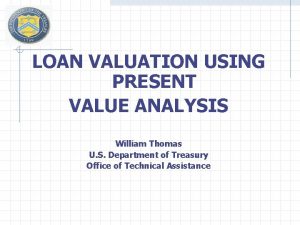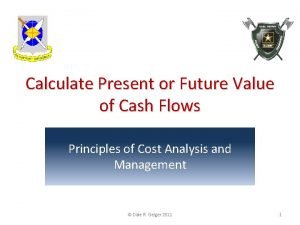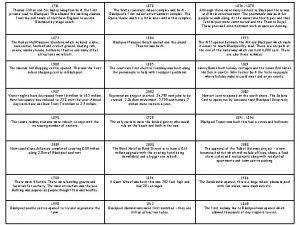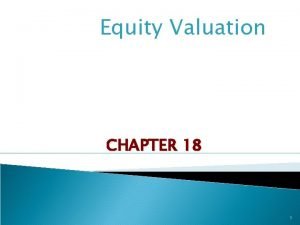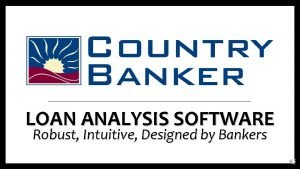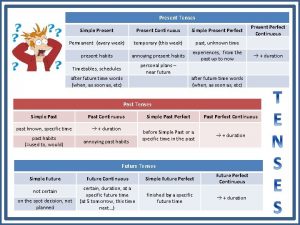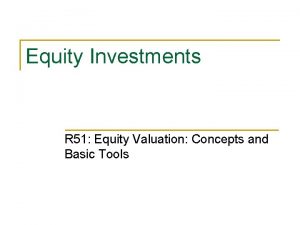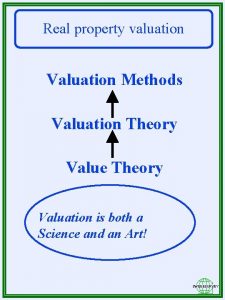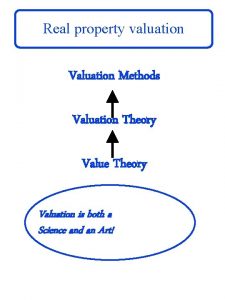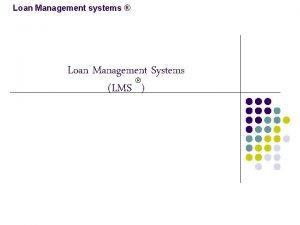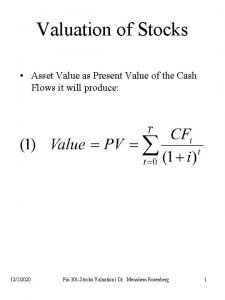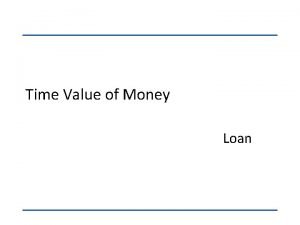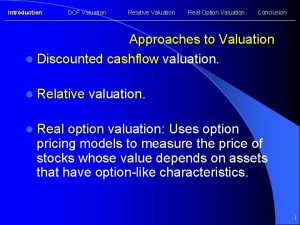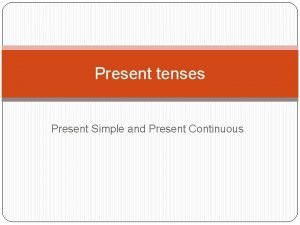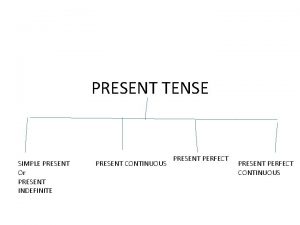LOAN VALUATION USING PRESENT VALUE ANALYSIS William Thomas

























- Slides: 25

LOAN VALUATION USING PRESENT VALUE ANALYSIS William Thomas U. S. Department of Treasury Office of Technical Assistance

OVERVIEW Ø This presentation covers loan classification and present value calculations used in the valuation of loans. Ø Ø Loan valuation is used for analyzing decisions regarding performing, sub-performing and nonperforming loans. Present value calculations, which include the analysis of risk and the time value of money, are required when asset disposition decisions have to be made.

Suggested Policy Proper credit decisions require the evaluation of collection alternatives on a comparable basis. Therefore, it should be the policy of LPS to employ present value techniques to assist in determining courses of action most advantageous to LPS in the liquidation of closed bank loans.

What is Present Value Analysis? Net present value: n NPV compares the value of a dollar today to the value of that same dollar in the future, taking inflation and returns into account. n If the NPV of a prospective collection exceeds the involuntary worst-case scenario, it should be accepted. n If NPV is negative, the offer should probably be rejected because cash flows are less than the worst case.

What is Present Value Analysis? Present value: n The current worth of a future sum of money or stream of cash flows given a specified rate of return n Future cash flows are discounted at the discount rate, and the higher the discount rate, the lower the present value of the future cash flows. n Determining the appropriate discount rate is the key to properly valuing future cash flows, whether they be earnings or obligations. Also referred to as "discounted value". n Put simply the basis is that receiving $1, 000 now is worth more than $1, 000 five years from now, because if you got the money now, you could invest it and receive an additional return over the five years.

What is Present Value Analysis? Time value of money: n n The concept that money available at the present time is worth more than the same amount in the future due to its potential earning capacity. This core principle of finance holds that, provided money can earn interest, any amount of money is worth more the sooner it is received.

Loan Classification Ø Determining loan status Ø Is the loan performing, sub-performing or non-performing? Ø Performing Loan Ø Ø Ø Paying as agreed (less than 30 days past due) Expected to pay in full under the terms of the note No serious past delinquency or file documentation problems Ø Sub-Performing Loan Ø The borrower is presently performing but is ultimately projected to default due to a severe negative event in the future Ø Maturity with balloon payment due Ø Major tenant move-out Ø Loss of other major customer

Loan Classification Ø Non-Performing Ø Ø Ø 30 days or more past due Past the note or modification maturity date Regardless of whether the borrower is making payments

Valuation of Performing Loans Ø Valuation Usage Ø Ø Ø Normally the first step in establishing a reserve price when selling to the secondary market. Also used to get borrowers to refinance by creating a discounted value. Refinancing should be encouraged for performing loans with extended maturities that are not readily saleable or when the market for a particular type of loan is limited. Ø Market Value Ø Performing loan value is calculated through a Mark-to-Market process in which the remaining payments are present valued using current market yield requirements for similar loans. The result of this discounting is called the Market Value.

Valuation of Performing Loans Ø Market Rate Ø Ø Performing loan market value is calculated by using a current market yield for similar types and quality of loans. The current market yield is comprised of a base rate, which is the rate for good quality, market-standard loans, adjusted for the characteristics of specific loans. Ø Base Rate Ø Ø May be well defined for loans such as residential mortgages. An estimation may be required for loans with unique terms. May be determined through recognized publications or through surveys of local lending institutions. These surveys should be recorded and updated periodically.

Valuation of Performing Loans Ø Adjusting the Base Rate Ø Specific loan factors can affect the base rate. These are determined by reviewing the loan file (due diligence. ) Ø Past delinquency history Ø Documentation deficiencies Ø Geographic location if the base rate does not reflect local lending practices. Ø The current market yield is the result of adjusting the base rate for any of these factors.

Valuation of Performing Loans Ø Adjusting the Base Rate Ø Here are some sample standardized adjustments used by the FDIC in valuing performing loans: Missing Documentation Original note/credit agreement Financial statement Credit file (including F/S) Adjustments 200 bp 100 bp 300 bp Credit More than 30 days delinquent 2 or more 200 bp times in the past year

Valuation of Performing Loans Ø Adjusting the Base Rate Ø Ø Ø Curable documentation deficiencies, such as a missing appraisal, should not be included in the standard adjustments. Sometimes it is more advantageous not to cure such deficiencies, though in this case, yield adjustments should be made. Adjustments for curable deficiencies should not exceed 100 bp.

Valuation of Sub-Performing and Non-Performing Loans Ø Present Value Methodology Ø Net Present Value of the Estimated Cash Recovery (NPV-ECR) Ø Based on a liquidation scenario Ø Established by estimating, over time, Ø Ø Ø Cash recoveries Direct expenses Payment of any prior liens Ø Estimated net cash flows are then present valued using an appropriate discount rate Ø This rate reflects the risk associated with: Ø The sources of the ultimate collection Ø The estimated timing of the cash flows

Valuation of Sub-Performing and Non-Performing Loans Ø Liquidation Scenario Ø Ø Decisions on a compromise, restructure or sale are based on the same established value. Broadly defined as the cash flows from: Ø Foreclosure/repossession, holding and sale of collateral. Ø Collection through litigation from identifiable assets of the borrowers or guarantors. Ø For sub-performing loans, NPV-ECR may also include projected principal and interest payments until default occurs.

Valuation of Sub-Performing and Non-Performing Loans Ø Analyzing Alternatives Ø Ø The liquidation scenario is essentially the worst-case scenario It should be used as a base-line in comparing other options, particularly a cash offer by the borrower to compromise the debt. The cash offer should have present value analysis performed at a realistic discount rate, factoring in down payment and perceived risk factors. This helps provide for a realistic counter-offer to the borrowers proposal and ultimately to justification for accepting the settlement for less than payment in full.

Valuation of Sub-Performing and Non-Performing Loans Ø To calculate the NPV-ECR: Ø Ø Ø Project quarterly cash flow estimates for the first two years, and annually thereafter. Project cash flows starting from the time the estimate is made. First quarter recoveries are those estimated to occur within 90 days, second quarter between 91 and 180 days, etc. Discount all cash flows quarterly, even if they are beyond the first two years. PV calculations assume all cash flows occur at the end of the period in which they are estimated. ECR cannot exceed total principal and interest due.

Projection of Cash Flows Ø Sources of Recovery Ø When estimating cash flows, consider all potential sources of recovery, including: Ø Collateral Ø Ø Ø Based on current appraisals Recognized publications Should be based on current values and not factoring in projected or expected future market changes Ø Other attachable or recoverable assets of borrowers and guarantors Ø Ø More subjective and should be very conservative Based on: Ø Financial statements Ø Credit reports Ø Asset searches and legal depositions

Projection of Cash Flows Ø Sources of Direct Expenses Ø Ø Type and amount vary by sources of recovery and collection laws For NPV-ECR, direct cash collection expenses include items such as: Ø Legal fees Ø Advances to protect asset (property tax, insurance, etc. ) Ø Payment of prior liens Ø Foreclosure costs Ø Selling expenses Ø Appraisal fees Ø Operating Expenses Ø Management fees Ø Other direct expenses not listed here

Projection of Cash Flows Ø Indirect Expenses No deduction should be made for indirect expenses such as the LPS’s internal overhead or administrative costs of doing business.

Timing of Cash Flows Ø The timing of estimated cash recoveries and expenses depends on: Ø Ø Repossession and foreclosure law Litigation and bankruptcy scenarios Estimated selling time foreclosed collateral Example: Ø If the foreclosure takes 3 months and holding period is six months, then the recovery is projected in the third quarter Ø The cash recovery is listed at the time of sale, not the time of foreclosure Ø Ø Expenses should be placed in the periods in which they are expected to occur. LPS could standardize certain time frames, such as foreclosure, repossession and holding periods for different types of collateral

When to Get Legal Assessment Ø When a projected recovery is based on the questionable outcome of a court decision: Ø Ø Ø The NPV-ECR should reflect counsel’s assessment of probable success An outcome is questionable when the probability is less than 75% The probability of success percentage provided by counsel should be applied only to those cash flows resulting from a successful outcome It would not affect any recoveries or expenses prior to or unrelated to the court decision If the probability is 75% or greater, no adjustment should be made

Documentation Ø The documentation required to estimate recoveries depends on the size and type of loan: Ø Ø Ø For very small loans, estimated recoveries may be based on existing information and credit information Certain mortgage loans may only require an appraisal to calculate NPV-ECR For larger loans efforts should be made to obtain documentation to establish the recovery estimate Ø Collateral appraisals, asset and lien searches, credit reports, financial statements, etc. Ø The collector’s personal feelings about the debtor or collectibility should not be factored in Ø Obtaining such information can often increase the valuation of the loan and outweigh the cost of gathering the information

Discount Rates Ø Measuring Risk Ø Discount rates used to present value the NPV-ECR measure the potential risk associated with: Ø Sources of recovery Ø The timing of the projected cash flows Ø An appropriate return on investment to LPS or a purchaser Ø For example: Ø Less risk should be associated with estimating recovery on a performing mortgage loan with a current appraisal than on an unsecured loan without current financial information.

Discount Rates Ø Discount Rates for NPV-ECR Ø Here are some sample discount rates used to present value the NPV-ECR that were utilized by the FDIC: Sources of ECR At least 20% of total ECR from Real Estate Collateral Less than 50% of total ECR from Real Estate Collateral Discount Rate Prime + 5 Prime + 7 ECR entirely from sources other than Real Estate Collateral (includes Unsecured loans) Prime + 10
 Fixed income valuation
Fixed income valuation Loan appraisal
Loan appraisal Contoh value creation adalah
Contoh value creation adalah Introduction to valuation the time value of money
Introduction to valuation the time value of money Present value table
Present value table Pathologist and anthropologist
Pathologist and anthropologist Clifton william henry thomas
Clifton william henry thomas William isaac thomas
William isaac thomas Company analysis and stock valuation
Company analysis and stock valuation Company analysis and stock valuation
Company analysis and stock valuation Equity analysis and valuation
Equity analysis and valuation Pvgo formula
Pvgo formula Loan presentation software
Loan presentation software Rumus present worth
Rumus present worth I write a letter now past continuous tense
I write a letter now past continuous tense Present perfect continuous affirmative
Present perfect continuous affirmative Schema present continuous
Schema present continuous Which verb tenses describe continuing action?
Which verb tenses describe continuing action? Present simple present continuous present perfect
Present simple present continuous present perfect Present simple present continuous present perfect
Present simple present continuous present perfect Present simple present continuous and present perfect
Present simple present continuous and present perfect Using system.collections.generic
Using system.collections.generic Defrost using internal heat is accomplished using
Defrost using internal heat is accomplished using Using line to create value
Using line to create value Preferred stock enterprise value
Preferred stock enterprise value Valrox
Valrox

